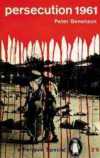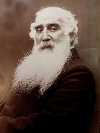 Amnesty International is a human-rights organization founded in 1961 by Englishman Peter Benenson. It campaigns internationally against the detention of prisoners of conscience, for the fair trial of political prisoners, to abolish the death penalty and torture of prisoners, and to end extrajudicial executions and “disappearances.” It was awarded the Nobel Peace Prize in 1977. The organization’s official symbol is a candle surrounded by what? Discuss
Amnesty International is a human-rights organization founded in 1961 by Englishman Peter Benenson. It campaigns internationally against the detention of prisoners of conscience, for the fair trial of political prisoners, to abolish the death penalty and torture of prisoners, and to end extrajudicial executions and “disappearances.” It was awarded the Nobel Peace Prize in 1977. The organization’s official symbol is a candle surrounded by what? Discuss
Source: The Free Dictionary
 This 1990 confrontation between the Mohawk nation and the town of Oka, Quebec, was the first of several violent conflicts between the First Nations and the Canadian government. It began when developers tried to turn a plot of land into a golf course. Because that land contained a burial ground and sacred pine grove, members of the Mohawk community blockaded the area. Canadian troops were sent in, and a 78-day standoff ensued, ending with the Mohawks’ surrender. What happened to the golf course?
This 1990 confrontation between the Mohawk nation and the town of Oka, Quebec, was the first of several violent conflicts between the First Nations and the Canadian government. It began when developers tried to turn a plot of land into a golf course. Because that land contained a burial ground and sacred pine grove, members of the Mohawk community blockaded the area. Canadian troops were sent in, and a 78-day standoff ensued, ending with the Mohawks’ surrender. What happened to the golf course?  Sankt Placidusfest is a religious procession held on July 11 at
Sankt Placidusfest is a religious procession held on July 11 at .jpg) Millie and Christine McCoy were American conjoined twins born to slaves and sold to showman J.P. Smith as infants. A rival showman kidnapped the girls, but Smith reclaimed them. He taught them to speak five languages, play music, and sing, and the twins enjoyed a successful career under the stage names “The Two-Headed Nightingale” and “The Eighth Wonder of the World.” In 1912, the girls died of tuberculosis just 17 hours apart. What was the title of the book sold at their public appearances?
Millie and Christine McCoy were American conjoined twins born to slaves and sold to showman J.P. Smith as infants. A rival showman kidnapped the girls, but Smith reclaimed them. He taught them to speak five languages, play music, and sing, and the twins enjoyed a successful career under the stage names “The Two-Headed Nightingale” and “The Eighth Wonder of the World.” In 1912, the girls died of tuberculosis just 17 hours apart. What was the title of the book sold at their public appearances?  The Khmer Rouge was a Cambodian Communist movement that was active as a guerrilla force from 1970 to the late 1990s and held power under the leadership of Pol Pot from 1975 to 1979. The Khmer Rouge is remembered largely for causing the deaths of up to 1.5 million people through execution, starvation, and forced labor. A tribunal consisting of both Cambodian and international judges was established in 2006 to try former Khmer Rouge leaders. Who were the “New People?”
The Khmer Rouge was a Cambodian Communist movement that was active as a guerrilla force from 1970 to the late 1990s and held power under the leadership of Pol Pot from 1975 to 1979. The Khmer Rouge is remembered largely for causing the deaths of up to 1.5 million people through execution, starvation, and forced labor. A tribunal consisting of both Cambodian and international judges was established in 2006 to try former Khmer Rouge leaders. Who were the “New People?”  Just a month after Nazi forces overran Poland and began distributing anti-Semitic propaganda there, the non-Jewish residents of the Polish town of Jedwabne took it upon themselves to round up and massacre Jews living in the area, burning hundreds alive. The fact that the Jedwabne Pogrom was not a German death squad operation but was actually “committed directly by Poles” was only recently established by the Polish Institute of National Remembrance. What details of the atrocity are still debated?
Just a month after Nazi forces overran Poland and began distributing anti-Semitic propaganda there, the non-Jewish residents of the Polish town of Jedwabne took it upon themselves to round up and massacre Jews living in the area, burning hundreds alive. The fact that the Jedwabne Pogrom was not a German death squad operation but was actually “committed directly by Poles” was only recently established by the Polish Institute of National Remembrance. What details of the atrocity are still debated?  This largest and best-known Scottish event in America, held since 1956 on
This largest and best-known Scottish event in America, held since 1956 on  Known as the “Father of Impressionism,” Pissarro was the only Impressionist painter who participated in all eight of the group’s exhibitions. He is notable not only for his paintings of rural and urban French life but in his role as a mentor to postimpressionists Paul Cézanne and Paul Gauguin. He gained popularity in the 1890s with his interpretation of nature, including many landscapes drawn from his surroundings in the French countryside. Why were many of his paintings destroyed in 1871?
Known as the “Father of Impressionism,” Pissarro was the only Impressionist painter who participated in all eight of the group’s exhibitions. He is notable not only for his paintings of rural and urban French life but in his role as a mentor to postimpressionists Paul Cézanne and Paul Gauguin. He gained popularity in the 1890s with his interpretation of nature, including many landscapes drawn from his surroundings in the French countryside. Why were many of his paintings destroyed in 1871?